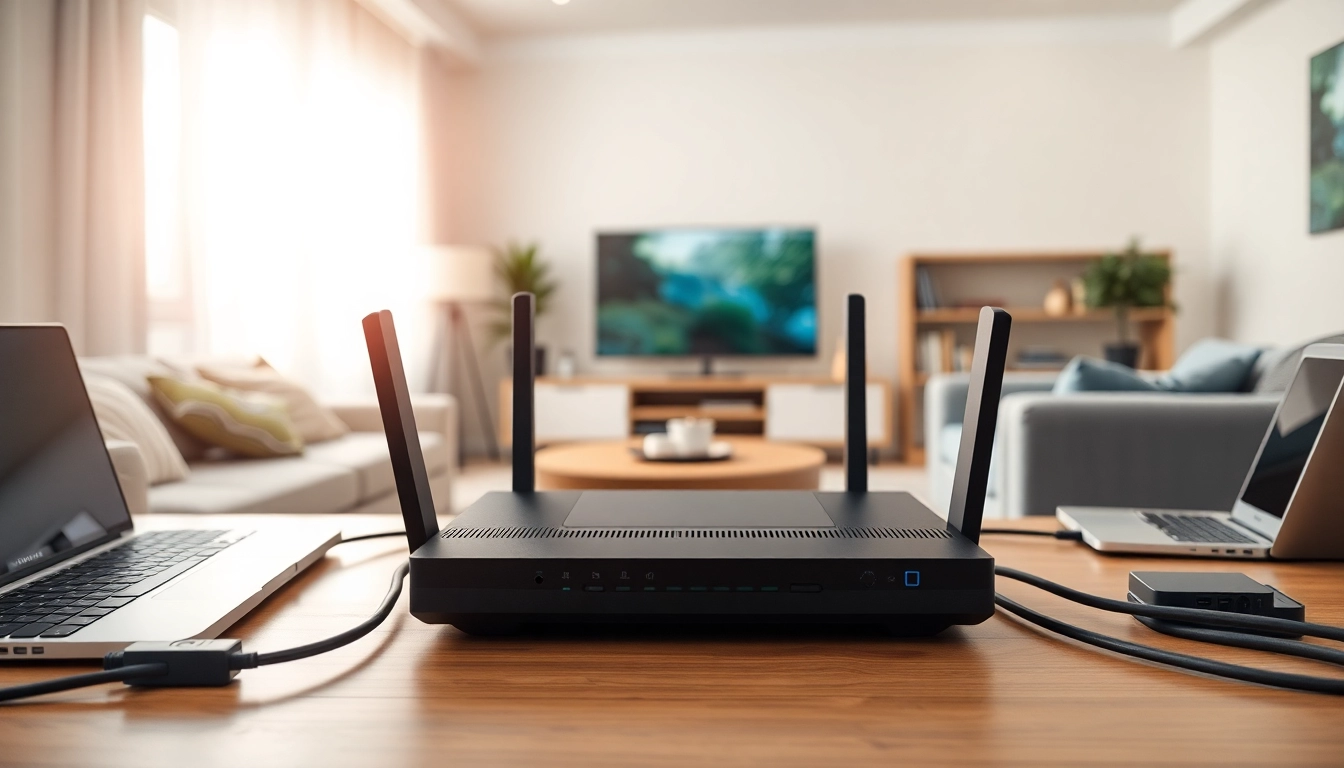Understanding Sonic vs AT&T Fiber: An Overview
In an era where reliable and high-speed internet connections are integral to daily living, the need to choose the right provider is more pressing than ever. Among the myriad of internet options available, fiber optic services are often heralded as the gold standard. This article delves into a comparative analysis of two notable fiber providers: Sonic and AT&T. Through this exploration, you will gain insights into features, pricing, customer experiences, and performance metrics, allowing you to make an informed decision when considering sonic vs at&t fiber.
Key Features of Sonic Fiber Plans
Sonic emphasizes simplicity with its fiber offerings. The company provides ultra-fast internet with only a single price point for various speed tiers. Currently, Sonic boasts impressive speeds of up to 10 Gbps, making it one of the fastest internet service providers available. One particularly appealing aspect is their straightforward approach with minimal pricing plans devoid of unnecessary complexities. Sonic Fiber also offers unlimited data usage, allowing consumers to relish their internet without the stress of data caps.
Moreover, Sonic emphasizes local customer service, focusing on customer support provided directly within the Californian region. This means customers can often reach a local representative who is well acquainted with the network and its nuances. Sonic’s commitment to maintaining an easy-to-understand interface and responsive support highlights its aim of customer satisfaction.
Key Features of AT&T Fiber Options
On the other hand, AT&T presents a more diverse range of plans, catering to different consumer needs and budgets. With options ranging from speeds of 300 Mbps to a staggering 5 Gbps, consumers can choose a plan that best suits their specific internet usage habits. Alongside varied speed selections, AT&T also offers attractive introductory pricing, which can significantly reduce bills in the initial months of service.
AT&T Fiber also provides additional features, such as versatile bundles that can include TV and mobile phone services, offering customers a package deal rather than just standalone internet. Reliability is a key word for AT&T as well; their extensive network infrastructure ensures availability in many urban and suburban areas. They also focus on security measures, integrating advanced firewalls and Internet security features within their services.
Comparative Speed Assessments
When it comes to speed, Sonic Fiber offers a clear edge with its top-tier speed reaching 10 Gbps. However, speed isn’t the only metric to consider; real-world performance can vary based on several factors including network congestion and distance from the service provider’s infrastructure. Although AT&T provides maximum speeds of up to 5 Gbps, this typically varies by certain locations, which may be a limitation for potential users living outside major urban centers.
Testing conducted in various conditions illustrates that Sonic Fiber maintains faster average speeds than many competitors, reinforcing its position as a prime choice for speed-conscious consumers. Yet, the actual speeds can often mimic AT&T’s under ideal conditions, showing that profound performance depends significantly on regional service availability.
Pricing Structures: Sonic vs AT&T Fiber
Base Pricing Models Explained
The starting point for Sonic’s pricing model is exceptionally straightforward. Currently standing at just $50 per month for its 10 Gbps plan, this price includes all necessary equipment and installation. The predictability of Sonic’s pricing structure is appealing to consumers who desire transparency and an assurance of no surprise fees.
Conversely, AT&T’s pricing begins relatively low, catering to various budgets with plans around $34 per month for lower-tier speeds. However, potential customers should be cautious, as prices can escalate depending on the speed chosen and additional features included. AT&T typically requires a commitment to a long-term contract which may deter some consumers who prefer flexibility.
Hidden Fees and Additional Costs
Hidden fees can sour the experience of even the best internet plans. Sonic prides itself on its transparent pricing model, generally not imposing hidden fees such as installation or data overage charges. Customers pay one flat fee, ensuring clarity on what to expect each month. This is particularly critical for budgeting households who appreciate predictability.
In contrast, while AT&T’s entry-level pricing appears attractive, it is essential for prospective customers to read the fine print. Activation fees, equipment rental charges, and fluctuating costs after promotional periods can significantly inflate the end price. Moreover, their bundles, while enticing, can sometimes lead to ancillary charges if not carefully considered—making it prudent for customers to assess these costs thoroughly before committing.
Best Value Packages Comparison
Evaluating the best value packages ultimately depends on individual needs. For users primarily seeking high-speed internet with no data cap, Sonic’s offer stands out as a great choice. Their single package simplifies the decision-making process while providing an exceptional level of service.
However, for households interested in bundled services, such as entertainment and mobile, AT&T’s options become significant contenders as they can often provide discounts if multiple services are combined. Their structure suits those who desire a one-stop-shop experience for internet, television, and mobile services.
Customer Experience: Support and Satisfaction
Service Availability and Coverage Analysis
Availability is paramount when determining internet service options. Sonic primarily focuses on California, making it a specialized choice for those residing within the region. Its localized service often yields better results in user satisfaction, as they are familiar with the area and can respond to issues more effectively.
AT&T, on the other hand, boasts national coverage across various states, ensuring a more extensive reach. This capacity can benefit consumers in mixed urban and rural locales. Still, customers should be wary of reported inconsistencies regarding service quality in remote areas, where other internet providers dominate.
Customer Reviews and Feedback
Customer satisfaction is a vital part of evaluating any service provider. Sonic generally enjoys positive reviews, particularly surrounding their customer support and quick response times. Users appreciate the absence of data caps and straightforward pricing, combining for a welcoming online experience.
In contrast, AT&T’s reviews echo a more varied experience among users. While many appreciate their initial pricing and fast connection, there are consistent notes regarding customer support frustrations, especially during peak demand periods. The long-term contracts can also draw mixed reactions—offering lower rates initially, but leading to dissatisfaction once the promotional period concludes.
Comparative Support Services
Support services are crucial for maintaining user satisfaction. Sonic shines here with its commitment to local customer service. Customers laud the interaction they receive, feeling that there is a personal touch sometimes absent in larger corporations.
Conversely, AT&T adopts a larger-scale customer service model. While there are often extensive resources available online (such as FAQs and troubleshooting guides), customers sometimes find the automated hotline interactions frustrating. Human support can be lengthy to reach, particularly during surges in service requests, and this can lead to dissatisfaction among consumers needing urgent assistance.
Performance Metrics: Speed and Reliability
Latency and Download Speeds
Measuring internet performance can often depend on speed and latency. Sonic Fiber typically boasts lower latency rates, which enhances the overall online experience, particularly for gamers and streaming enthusiasts. These reduced latencies can create a seamless user experience, allowing for smooth streaming, gaming, or video conferencing.
AT&T’s performance in latency is acceptable, yet may not match Sonic’s rates. Shared lines can occasionally lead to increased latency when many users engage simultaneously during peak hours. Additionally, their infrastructure can experience variable speed drops during high network congestion periods, impacting user experience.
Network Reliability Reviews
Reliability is essential when it comes to internet service providers. Sonic’s network performance is frequently rated highly due to its dedicated lines and minimal downtime. Users often praise the consistency in service, reinforcing the brand’s commitment to premium offerings.
AT&T, with its expansive network, also boasts satisfactory reliability; however, user experiences reveal inconsistencies dependent on locality. In some regions, users report frequent outages, diminishing their reliability rating. Thus, users should take care to research the experiences of current customers in their neighborhoods before committing.
Real-World Usage Scenarios
Understanding how these services perform in real-world usage scenarios can benefit potential customers. For a household that streams multiple devices, video conferencing, and online gaming simultaneously, Sonic likely proves to be the preferable option. The consistent high speeds and unlimited data allow families to utilize the internet to its fullest extent without interruptions.
In contrast, AT&T’s service may perform adequately in household scenarios with moderate internet use, but may not keep up as well under heavy usage. Families that primarily use the internet for browsing, light streaming, and social media may find the provided services suitable, though if entertainment and gaming are pivotal, they may wish to consider investing in higher tier plans.
Conclusion: Choosing Between Sonic vs AT&T Fiber
Advantages of Choosing Sonic Fiber
The primary advantages of selecting Sonic Fiber include simplicity in pricing, impressive speeds, and outstanding local customer support. Sonic delivers consistent performance while eliminating the worry of hidden fees, showing strong value for those seeking a clear-cut internet experience. Additionally, their unlimited data offering signifies an appeal for heavy users who wish to engage without restrictions.
Advantages of Choosing AT&T Fiber
AT&T Fiber’s notable advantages include a wider service availability and the option for bundling diverse services into one package. Their diverse array of plans can suit varied users, granting flexibility depending on budget and usage needs. They often provide good promotional offerings, especially for lower-tier options, and for those whose browsing needs are modest, these can yield value.
Final Recommendations for Consumers
When it comes down to the choice between Sonic and AT&T Fiber, the decision ultimately hinges upon individual needs and local availability. Users focused on speed, ease, and customer service may find Sonic to be the superior choice. On the other hand, if options for bundling services and flexibility are a priority, AT&T could structure well to meet those expectations. Above all, consider researching local reviews and assessments, as on-the-ground experiences can significantly influence service satisfaction. Understanding the ongoing dynamics between sonic vs at&t fiber can help you make an informed decision aligned with your internet use case.



